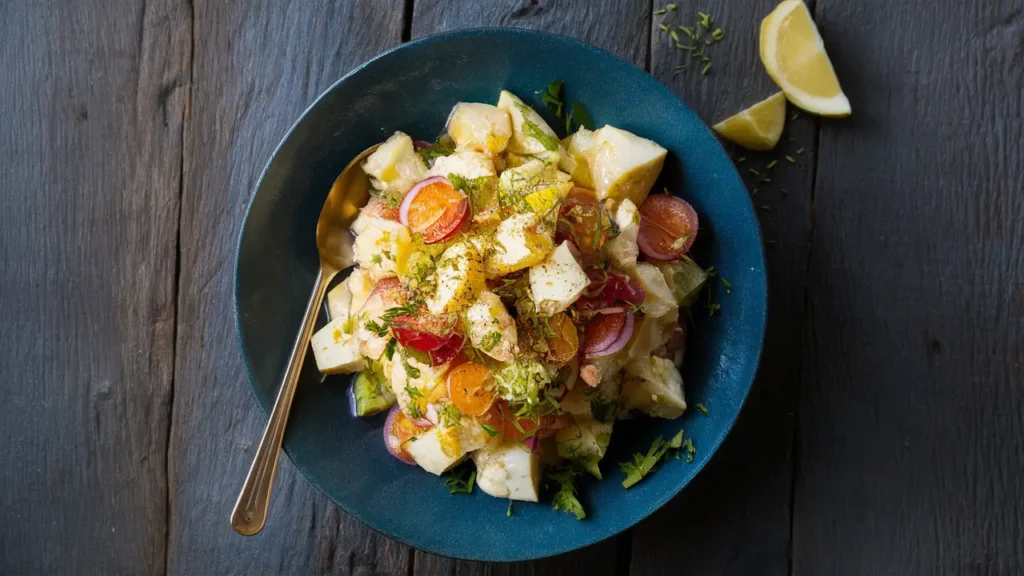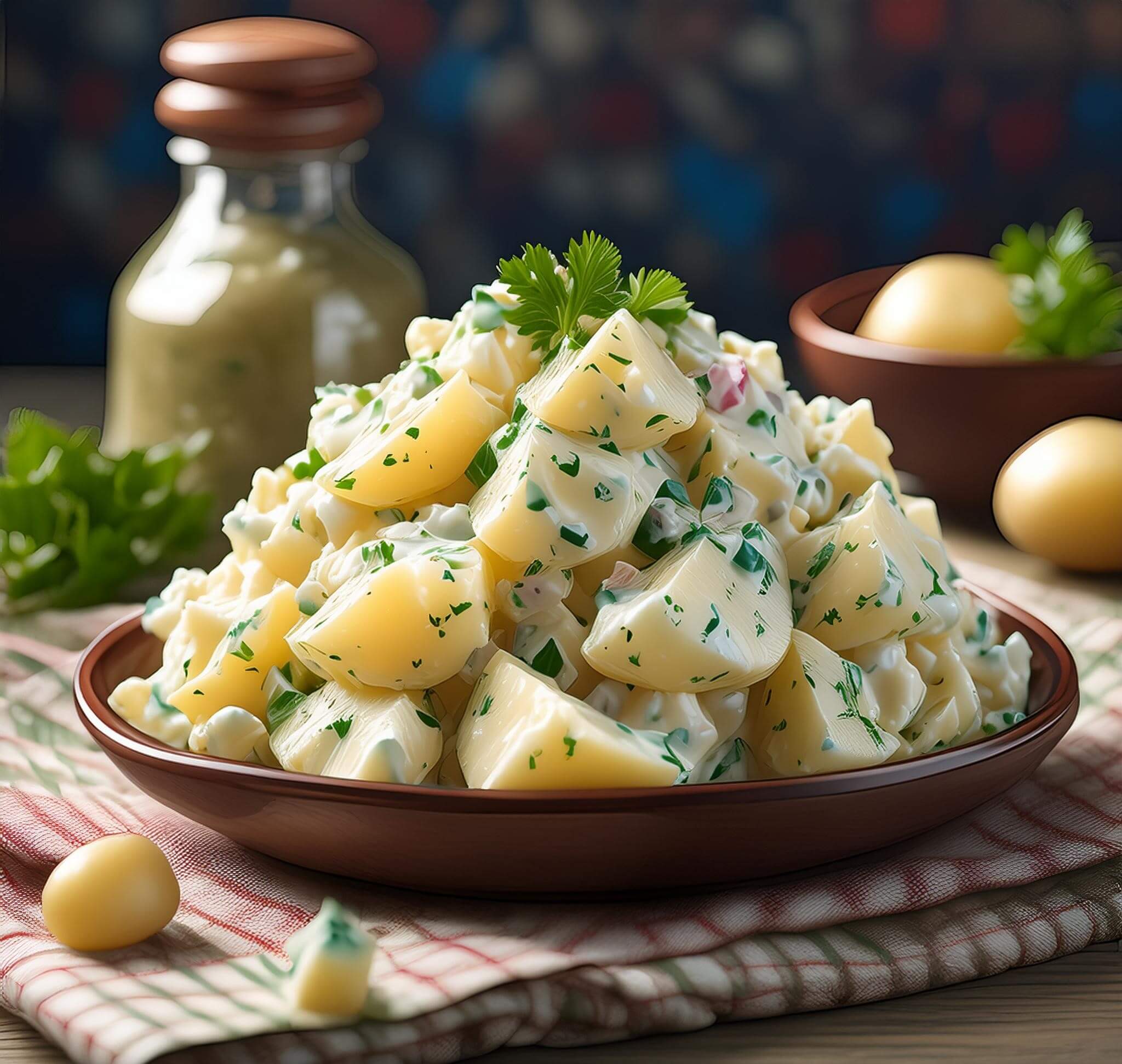Introduction to Boiling Potatoes for Potato Salad
Potato salad is a staple at many gatherings, where the creamy texture and cool, tangy taste provide a delightful contrast to grilled mains and vibrant greens. The key to a sensational potato salad lies in the initial step—boiling the potatoes perfectly. Properly boiled potatoes form the foundation of a great potato salad, affecting everything from texture to flavor absorption. This introduction will explore why meticulous potato boiling is crucial and what factors significantly affect the boiling process, ensuring that your potato salad is a hit at any feast.
Importance of Proper Potato Boiling for Potato Salad
The process of boiling potatoes for potato salad is crucial as it determines the texture of the potatoes, which in turn impacts the overall consistency and flavor of the dish. Well-boiled potatoes will enhance the salad’s texture, provide a soft bite yet hold their shape, and absorb the dressing evenly, allowing for a harmonious blend of flavors. Here’s why you should pay attention to how you boil your potatoes:
- Texture and Consistency: Properly boiled potatoes offer the right balance of tenderness and structure, making them easy to mix with other ingredients without disintegrating.
- Flavor Absorption: Evenly cooked potatoes are like sponges for your dressing; they absorb condiments and spices more effectively, distributing the flavors throughout the salad uniformly.
Overview of Key Factors Influencing Boiling Time
Boiling potatoes is an art that requires consideration of several factors to achieve perfect results:
- Type of Potato: The choice of potato matters greatly. Waxy potatoes like Yukon Gold or Red potatoes hold their shape and have a creamy, moist texture, making them ideal for salads.
- Size and Cut: Whole potatoes cook differently than diced or sliced ones; smaller cuts cook faster but are also more prone to overcooking.
- Starting Temperature: Placing potatoes in cold water and then bringing them to a boil allows for even cooking, which is crucial for a good potato salad.
- Water Salinity: Salted water not only seasons the potatoes deeply but also influences the boiling temperature and time.
- Cooking Time: Varies based on the potato type and size. It’s essential to start checking for doneness periodically to avoid mushy or undercooked potatoes.
Understanding these factors will help you master the art of boiling potatoes and set the stage for a flawless potato salad. Next, we will delve deeper into each factor, explaining how they contribute to perfectly cooked potatoes. Whether you are preparing a classic American potato salad or an avant-garde version with unique ingredients, starting with excellently boiled potatoes is key. Let’s ensure your potato salad stands out with its impeccable texture and flavor profile.

Factors Affecting Boiling Time
The boiling time of potatoes can vary significantly based on several factors. Understanding these can help you achieve perfectly cooked potatoes that are neither too hard nor too mushy but just right for your potato salad. Below, we detail how the type of potatoes and the size and thickness of the potato chunks can influence your cooking process.
Type of Potatoes Used
The type of potato you choose is critical and can be the deciding factor in the texture of your potato salad:
- Waxy Potatoes: Such as Red Bliss, New Potatoes, and Fingerling varieties, are ideal for boiling for potato salad because they hold their shape well during and after cooking. These potatoes have a low starch content and firm texture, which helps them remain intact in salads. Typical boiling time for whole waxy potatoes is about 15-20 minutes.
- Starchy Potatoes: Varieties like Russet or Idaho are high in starch and tend to break down easily when boiled, which can be beneficial for mashed potatoes but undesirable for potato salad where you want the pieces to hold their shape. If using starchy potatoes, they should be monitored closely and possibly removed from the water earlier than waxy types. Boiling time for whole starchy potatoes typically ranges from 20-30 minutes.
- All-Purpose Potatoes: Yukon Gold and White potatoes have moderate starch content and are quite versatile. They can hold their shape fairly well but are not as firm as waxy potatoes. They offer a good balance between texture and flavor absorption. Boiling time for these ranges from 18-25 minutes for whole potatoes.
Size and Thickness of Potato Chunks
The cut of your potatoes will not only impact the boiling time but also affect the final texture of your potato salad:
- Whole Potatoes: Cooking potatoes whole is slower but can result in a more even texture and don’t absorb too much water, which is ideal for salads. This method is recommended if you have the time and want to cut them after boiling.
- Cubed or Sliced Potatoes: Cutting potatoes into smaller chunks or slices will decrease the cooking time significantly. This is useful if you’re in a hurry, but be aware that smaller pieces are more susceptible to becoming overcooked and mushy. To avoid this, start checking for doneness sooner than you would with whole potatoes.
- Cubes (1/2 inch to 1 inch): Boil for about 10-15 minutes.
- Slices (1/2 inch thick): Boil for about 5-10 minutes.
- Consistency in Cutting: Ensure all potato pieces are approximately the same size and shape to promote even cooking. Uneven pieces will not cook uniformly, which can lead to a mix of overcooked and undercooked potatoes in your salad.
By choosing the right type of potato and cutting it to the appropriate size, you can control the cooking process more effectively and produce a potato salad with the perfect consistency and flavor. Adjustments might be necessary based on the specific variety of potato and the desired firmness for your salad. In the next section, we will explore optimal boiling practices to maximize flavor and texture in your potatoes. These practices will help you refine your boiling technique to produce the best possible base for your potato salad.

Optimal Boiling Time for Potato Salad Potatoes
Achieving the perfect texture for potato salad begins with boiling the potatoes just right. Not all potatoes should be boiled the same way for potato salad, as the type and cut of potato can significantly impact the final product. This section provides general guidelines for boiling potatoes and specific adjustments needed for different potato varieties to ensure that every bite of your potato salad is perfectly tender and flavorful.
General Guidelines for Boiling Potatoes
Boiling potatoes for salad is an art that requires attention to detail. Here are some tips to assist you in achieving the best results:
- Starting Cold: Always start with cold water. This ensures that the potatoes cook evenly throughout. Put the potatoes in a pot, cover them with cold water, then bring the pot to a boil.
- Salting the Water: Salt the water generously. This does not just season the potatoes, but it also helps them cook better by changing the boiling point of the water.
- Maintain a Gentle Boil: Once the water has reached a boil, reduce it to a simmer. A vigorous boil can break apart the potatoes, especially if they are cut into smaller pieces.
- Testing for Doneness: Begin testing the potatoes for doneness after about 10 minutes of boiling for cut pieces and 20 minutes for whole potatoes. The best test is to poke them with a fork. If the fork goes in easily without resistance, they are done.
- Cooling Down: After boiling, drain the potatoes and let them cool for a few minutes in the colander before mixing them with other ingredients. This prevents the dressing from becoming oily and helps maintain the integrity of the potato pieces.
Adjustments for Different Potato Varieties
Different types of potatoes have their unique characteristics and require specific cooking times:
- Waxy Potatoes (e.g., Red Bliss, Fingerling):
- Boil Whole: 15-20 minutes
- Boil Cubed: 10-15 minutes
- These potatoes are ideal for salads as they hold their shape and texture well during cooking. They are less likely to become grainy or mushy.
- Starchy Potatoes (e.g., Russets):
- Boil Whole: 20-30 minutes
- Boil Cubed: 15-20 minutes
- Starchy potatoes are prone to breaking down, so they may not be the best choice for a salad that needs to hold up under dressing. If you use them, watch them closely and test frequently for doneness.
- All-Purpose Potatoes (e.g., Yukon Gold):
- Boil Whole: 18-25 minutes
- Boil Cubed: 12-18 minutes
- These potatoes are a middle-ground between waxy and starchy. They hold up better than Russets but are softer and more flavorful than most waxy varieties.
Pro Tips:
- Size Matters: The smaller you cut the potatoes, the faster they will cook. Remember that smaller, more uniform pieces not only cook quicker but also are more likely to cook evenly.
- Acid Helps: Adding a little vinegar to the boiling water can help the potatoes firm up and resist breaking down, making them ideal for mixing into salad.
Following these guidelines and making adjustments based on the type of potatoes used will help you boil them perfectly for your potato salad. Ensuring the potatoes are properly boiled is key to a great potato salad; it influences not only the salad’s texture but also how well the potatoes absorb dressings and meld with other ingredients. Up next, we’ll delve into how to properly dress and season your potatoes to enhance their flavor in the salad.
Preparation Before Boiling
Before the potatoes ever hit the boiling water, proper preparation is key to ensuring they cook evenly and absorb the dressing beautifully in your potato salad. This preparation involves washing and possibly peeling the potatoes, followed by cutting them into uniform pieces. Each of these steps is critical for achieving the ideal texture and flavor in your potato salad.
Washing and Peeling Potatoes (If Desired)
- Washing: Begin by thoroughly rinsing the potatoes under cold running water to remove any dirt, pesticides, or residues from their skins. It’s important to clean them even if you plan to peel them later, as this prevents any surface dirt from contaminating the potato flesh.
- Use a Brush: For potatoes with particularly dirty or gritty skins, use a vegetable brush to scrub their surfaces gently.
- Rinse Well: Make sure all traces of dirt are gone by giving them a final rinse.
- Peeling: Whether or not to peel potatoes for salad depends on the type of potato and the desired texture and presentation of the dish.
- Waxy Potatoes: These often have thinner, smoother skins that are typically left on for texture and color, as they provide a nice contrast in the salad and are easier to digest.
- Starchy Potatoes: These usually have thicker skins that may be peeled to prevent the salad from becoming too mushy or gritty.
- Personal Preference: Ultimately, whether or not to peel comes down to personal preference and the specific recipe you’re following.
Cutting Potatoes into Uniform Chunks
- Choosing the Right Size: The size of the potato chunks will affect both the cooking time and the salad’s final texture.
- Small to Medium Chunks: Ideal for quick, even cooking and easy eating. Typically, 1/2 inch to 1 inch cubes are preferred.
- Consistency: It is crucial that all pieces are roughly the same size; this uniformity ensures they cook at the same rate and each bite of salad is consistent.
- Method:
- Peeling First: If you are peeling the potatoes, do it before cutting them into chunks. Use a sharp vegetable peeler and take care not to remove too much of the potato flesh.
- Cutting Techniques: Place the potato on a cutting board and, using a sharp knife, slice it first into rounds, then stack several rounds and slice them into sticks, and finally, chop across the sticks to create cubes.
- Avoiding Browning: Potatoes can start to brown once they’re cut, due to exposure to air. To prevent this:
- Use Cold Water: Immediately submerge the cut potatoes in cold water. This stops the browning process and also removes some of the surface starch, which can help in achieving a cleaner, crisper texture once cooked.
- Ready to Boil: Once your potatoes are cut into uniform pieces and rinsed, they’re ready to be boiled. This process, when done correctly following the aforementioned guidelines, will ensure your potatoes are perfectly prepared for the next stages of making potato salad.

V. Boiling Techniques
The technique used in boiling potatoes for potato salad can significantly influence their flavor and texture. Proper boiling not only ensures they are cooked through but also enhances their taste and prepares them for dressing. This section will cover the essentials of using salted water for flavor enhancement and how to boil the potatoes to the perfect fork-tender consistency.
Using Salted Water for Flavor Enhancement
Salt is not just a seasoning but a crucial ingredient in the boiling process that impacts the texture and the overall flavor profile of the potatoes:
- Why Salt the Water?
- Flavor Infusion: Salt penetrates the potatoes, seasoning them from the inside out, which water alone cannot achieve.
- Texture Management: It helps firm up the potatoes by interacting with their pectin, making them less likely to fall apart when mixed with other ingredients.
- How Much Salt?
- General Guideline: Use about 1 tablespoon of salt per quart of water. This ratio can be adjusted depending on personal taste and health considerations.
- Taste Test: After dissolving the salt, taste the water. It should be pleasantly salty which ensures the potatoes have enough seasoning.
- Adding Salt:
- When to Add: Salt should be added to the water before bringing it to a boil to ensure it dissolves completely.
- Dissolution: Stir the water after adding salt to help it dissolve faster and more evenly.
Boiling Potatoes Until Fork-Tender
Boiling the potatoes to the right level of tenderness is essential for the perfect potato salad:
- What Does Fork-Tender Mean?
- Definition: Fork-tender potatoes are those that can be easily pierced with a fork without falling apart. The fork should go in with little resistance and come out clean.
- Testing for Doneness:
- Fork Test: Start testing the potatoes 5 minutes before you expect them to be done. Insert a fork into one of the potato chunks; if it slides in easily, they are ready.
- Visual Cues: Look for a slight fluffiness on the edges of the potatoes. This indicates they are cooked perfectly for mashing into a salad where they need to hold their shape but also blend with other ingredients.
- Boiling Process:
- Time Management: Depending on the potato cut and size, boiling can take anywhere from 10 to 25 minutes. Whole small potatoes will take closer to 25 minutes, while diced potatoes cook in about 15 minutes.
- Consistency Check: Make sure all the potatoes are cut uniformly to ensure they cook evenly. Stir the pot occasionally to make sure none stick to the bottom, which can cause uneven cooking.
- Post-Boil:
- Draining: Once the potatoes are fork-tender, drain them immediately. Letting them sit in hot water can cause them to continue cooking, which might lead to mushiness.
- Cooling: Spread them out on a flat surface or a colander to cool. This stops the cooking process and prevents them from becoming overly soft.
Pro Tips:
- Avoid Overcrowding: Cook in batches if necessary. Overcrowding the pot can lead to uneven cooking and water temperature fluctuations.
- Acidic Touch: Adding a splash of vinegar to the boiling water can help the potatoes hold their shape better by strengthening their cellular walls, which is especially helpful for starchy potatoes.
FAQs
- How long should you boil potatoes?
Answer: Boil potatoes for about 10-15 minutes until they’re fork-tender but not mushy, ensuring they’re cooked through yet firm enough for potato salad. - How can you ensure potatoes are not overcooked for potato salad?
Answer: To avoid overcooking, check potatoes frequently towards the end of boiling time and remove them promptly once they’re just tender enough for a fork to pierce through easily. - Is it better to boil potatoes whole or cut up for potato salad?
Answer: It’s better to cut potatoes into uniform chunks before boiling for potato salad, ensuring even cooking and allowing flavors to penetrate more effectively. - Should you add salt to water when boiling potatoes for potato salad?
Answer: Yes, adding salt to the boiling water enhances the flavor of potatoes. Aim for a tablespoon of salt per gallon of water for optimal seasoning.

